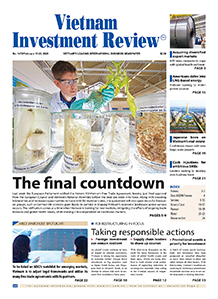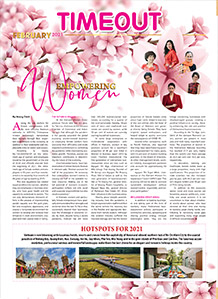Upskilling focus takes priority for Vietnam
The Ministry of Education and Training in late April was tasked by the Vietnamese government to design feasible solutions and policies to encourage training of high-quality personnel for the economy, especially for prioritised and emerging sectors such as AI, semiconductors, and high technology.
Moreover, the ministry was also ordered to review the labour market, with effective solutions to provide more employment for those having no jobs and may be kicked out of the labour market due to economic difficulties, especially those working at exporting enterprises affected by global uncertainties including US high tariff infliction.
 |
Latest figures from the National Statistics Office (NSO) showed that in Q1 of 2025, the number of employees in Vietnam was estimated to have been nearly 53 million, down by 230,700 people on-quarter.
Those working in the agro-forestry-fishery sector are 13.5 million (26 per cent of total), down by 47,200 people on-quarter and 305,000 on-year. Those working in the industrial and construction sector numbered 17.3 million (33.3 per cent of total), down by 287,100 people on-year and up by 262,700 people on-year.
The service sector housed 21.1 million labourers, up by 100,300 people on-quarter and also up by 574,400 people on-year.
However, the NSO reported that there are many limitations in the domestic labour market now.
“The labour market continues to recover, but the quality of labour supply remains limited, failing to meet the labour demand of a modern, flexible, sustainable and integrated labour market,” the NSO said. “The whole country has only 28.8 per cent of trained workers with degrees and certificates, and it currently lacks both labourer quantity and technical expertise, especially high-quality human resources. Many new jobs are still using simple, seasonal and unstable labourers.”
The NSO added that the rate of informal employment remained high at 64.3 per cent in Q1, up 0.7 percentage points compared to the previous quarter. In Q1 of 2025, the country saw 36,400 enterprises newly registered, down 4 per cent in the number of enterprises and also down 14.6 per cent in the number of employees on-year. Moreover, 78,800 enterprises withdrew from the market.
“The number of enterprises kicked out of the market remains high, directly affecting employment opportunities, especially in sectors using a lot of unskilled labourers such as textiles, construction, and manufacturing,” the NSO stressed.
In addition, the number of unemployed people at the working age in Q1 of 2025 was about 797,000 people, up by 32,400 people on-quarter but down by 136,000 people on-year.
According to the Ministry of Industry and Trade (MoIT), the employment situation in Vietnam this year might be affected as enterprises involving export and import activities are finding it difficult to develop, especially those that have trade activities with the US.
The US currently accounts for almost 30 per cent of Vietnam’s total export turnover. Vietnam is also now the eighth-largest trade partner of the US. Vietnam has triggered negotiation of a trade deal with the US in hope of seeing reduced tariffs, and stands ready to eliminate tariffs on US goods.
However, it is projected by the MoIT that the existing 10 per cent reciprocal tariff from the US will have a strong adverse impact on most of Vietnam’s key export groups to the US, such as textiles and footwear (21.9 per cent of Vietnam’s total export turnover), wood and wood products (7.58 per cent), and agro-forestry-fishery items (3.45 per cent).
“The high reciprocal US tax rate will cause significant negative impacts on Vietnam’s key export industries and related labour markets,” the NSO added.
It has pointed out that enterprises producing export goods related to six groups of goods accounting for over 70 per cent of Vietnam’s total export turnover will be affected: electronic computers and components; machinery, equipment, tools, and spare parts; assorted phones and components; textiles and garments; footwear; and wood and wood products.
“To minimise the impact, enterprises need to seek new markets, improve product quality, and diversify products. The government also needs to have policies to support enterprises and workers,” the NSO suggested.
In February, the Vietnamese government approved a scheme on developing a system of training centres and talents for Industry 4.0 by 2030. This will contribute to realising the country’s plan to produce 50,000-100,000 high-skilled workers for the semiconductor sector for the 2025-2030 period.
The scheme aims to establish networks of centres of this type. Particularly in the sectors of AI, semiconductor, and biotechnology, several networks in the country’s three main regions will be founded. Each network is to be led by one strong university, and participated in by at least five universities and a number of domestic and foreign enterprises.
In particular, the scheme proposes amendments and supplementation to the state’s investment support mechanisms on constructing facilities and equipment in service of training activities, scientific research, innovation, and startups based on investment cooperation between businesses and higher education institutions.
What the stars mean:
★ Poor ★ ★ Promising ★★★ Good ★★★★ Very good ★★★★★ Exceptional
Related Contents
Latest News
More News
- Businesses ramp up production as year-end orders surge (December 30, 2025 | 10:05)
- Vietjet chairwoman awarded Labour Hero title (December 29, 2025 | 13:06)
- How to unlock ESG value through green innovation (December 29, 2025 | 10:03)
- AI reshapes media and advertising industry (December 29, 2025 | 08:33)
- FPT and GELEX sign deal to develop blockchain tech for global markets (December 29, 2025 | 08:29)
- Vietnam’s GDP forecast to grow by 9 per cent in 2026 (December 29, 2025 | 08:29)
- Women entrepreneurs are key to Vietnam’s economic growth (December 29, 2025 | 08:00)
- Vietnam's top 500 value-creating enterprises announced (December 27, 2025 | 08:00)
- The PAN Group shaping a better future with ESG strategy (December 26, 2025 | 09:00)
- Masan Consumer officially lists on HSX, marking the next phase of value creation (December 25, 2025 | 13:20)

 Tag:
Tag:




















 Mobile Version
Mobile Version